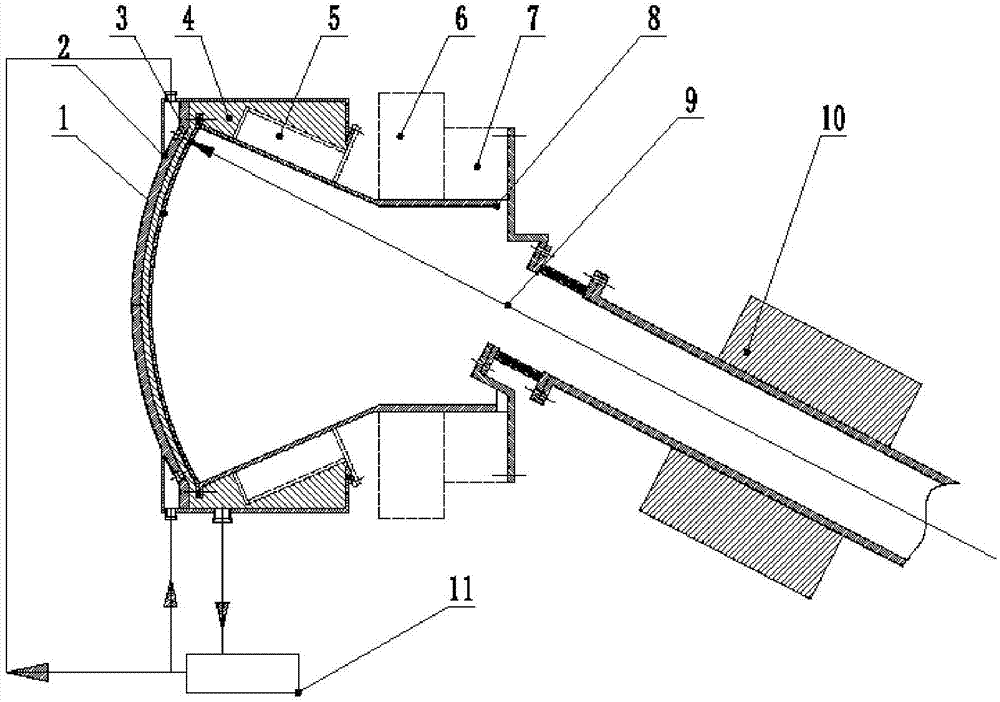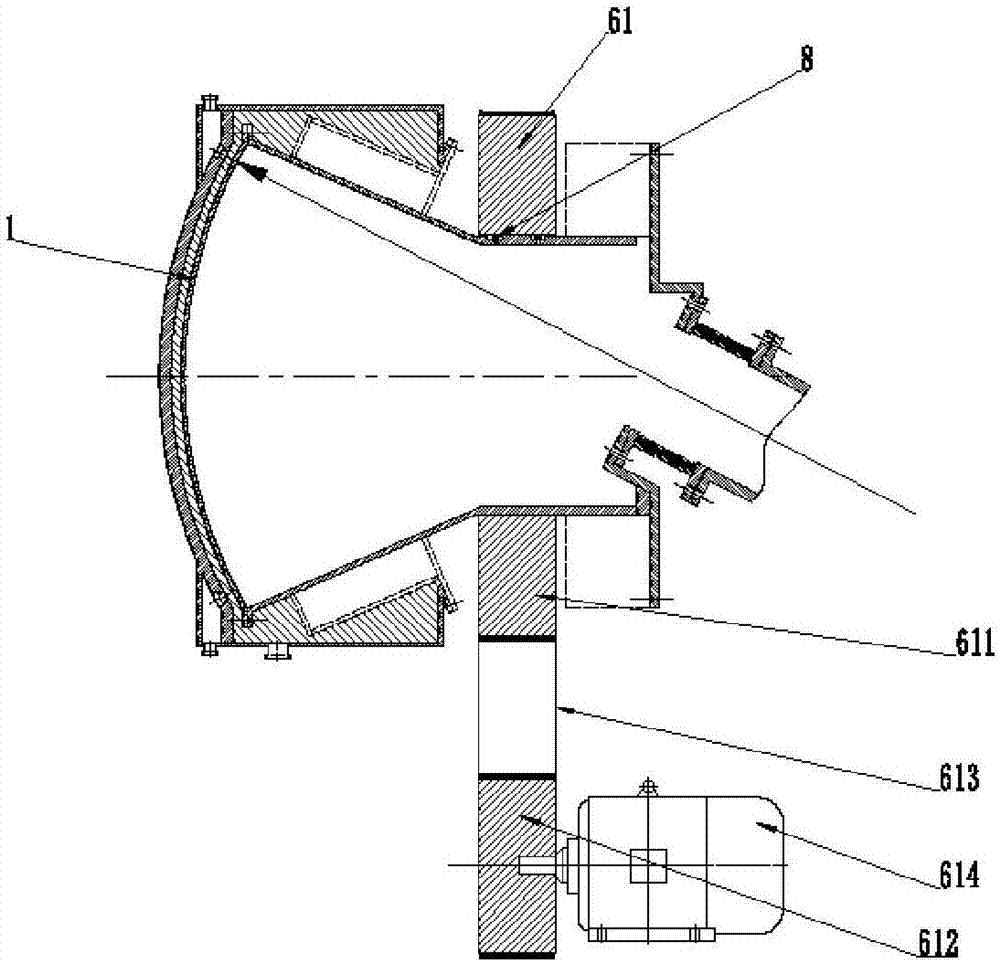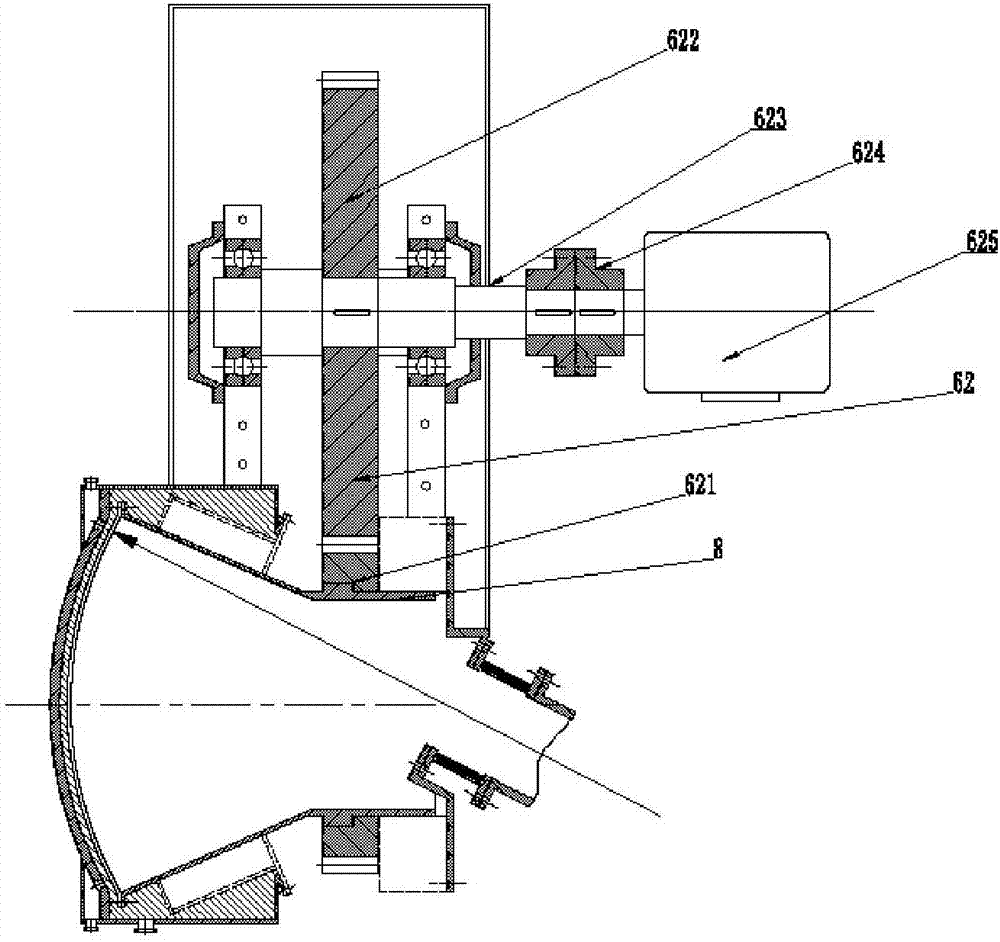For the experimental needs of higher neutron source intensity, the current solution cannot be realized
[0005] Based on existing solutions, the target film can withstand more than 100kw / cm 2 When the heat is deposited, it is necessary to greatly increase the diameter of the target piece and increase the speed of the target piece, reduce the time for a single point to bear heat, and improve the heat dissipation capacity of the water-cooled structure. According to the numerical simulation analysis results, the target piece can withstand 100kw / cm 2 Heat deposition requires a target diameter of at least 500mm and a rotational speed of about 10,000rpm. For such high index parameters, the existing solutions cannot fully meet the requirements, and the increase in the rotational speed and the increase in the target diameter have an effective effect on the heat dissipation of the target There is a limit value (the rotation speed and the diameter of the target piece reach a certain level, and the water cooling structure will not be able to dissipate heat in time when the target piece is exposed to heat), the target system only uses a belt drive to drive the target piece with a diameter of about 200mm to rotate, and the speed is about 1100rpm. The speed continues to increase, and the expected speed cannot be achieved only by belt transmission, not only because of belt slippage, low transmission efficiency, etc. There is a big problem with the structural stability under high pressure (the current water cooling method will cause a pressure load greater than 0.8MPa on the target piece)
[0006] For the neutron source target system with higher source intensity, based on the existing solutions, there is also a big problem in its dynamic sealing. During the transmission of the deuterium beam, a certain degree of vacuum needs to be maintained, generally 10 -3 Pa~10 -5 Between Pa, it is necessary to use a vacuum dynamic sealing structure between the moving target system and the stationary accelerator. Similarly, for the operating target system, it is necessary to dynamically seal the cooling medium to prevent the cooling medium from leaking to the outside in the high-speed rotating target system On the one hand, the leaked cooling medium will affect the normal operation of other systems, and at the same time, the leakage of the cooling medium permeated with radioactive tritium will cause environmental pollution and be difficult to recycle. Based on the existing solutions, the cooling medium is water
[0007] The current vacuum dynamic sealing structure has two types: wear-resistant packing seal and magnetic fluid seal. Only packing seal is used as the vacuum dynamic sealing structure. No matter what material is used, it has the disadvantages of short service life and needs to be replaced regularly. , Regular replacement of key components will cause problems such as difficulty in personnel radiation protection and increase in radioactive waste. The magnetic fluid seal structure currently used is a traditional structure, that is, the bearing and the magnetic fluid seal are integrated. Generally, the bearings are symmetrically distributed on both sides, and magnets are installed in the middle. The action of the magnetic field binds the ferrofluid in the slit groove between the dynamic and static parts to achieve the sealing effect. The ferrofluid seal is a better solution for the vacuum dynamic seal, but this structure also has limitations. In a system with a low speed (below 3000rpm), the magnetic fluid can play a good sealing role. When the speed increases or the diameter of the rotating shaft increases, the linear velocity at the dynamic seal increases, and it will directly reach the components and bearings. As the temperature rises, the cooling in the existing magnetic fluid structure is difficult to cool to the sealing interface. The heat-resistant temperature of the magnetic fluid is generally 120°C. The temperature of the bearing is transferred to the magnetic fluid and the magnet, which will directly cause the magnetic fluid to evaporate or The magnet demagnetizes and loses the sealing effect
[0008] The current dynamic sealing structure of the cooling medium basically uses lengthening of the vacuum chamber and enlarging the cooling chamber to allow the water to fall back freely, with some packing seals as an auxiliary. As mentioned above, the packing seal is not suitable for the target system of the neutron source. When the speed is too high, it is also not advisable to adopt the method of water falling freely
[0009] Similarly, the cooling of the target in the existing solution uses water as the cooling medium, and the back of the target uses a direct spray water structure, that is, water with a certain pressure is used to spray the target. This structure is simple, but convective heat transfer Efficiency is only 3kW / m 2 About K, based on the calculation formula of heat transfer, it can be known that for 100kw / cm 2 heat deposition, this water-cooled structure cannot meet the requirements
[0010] In addition, the target sheet in the current neutron source target system is currently made of copper material. Copper has good thermal conductivity, but the mechanical strength of copper is also low. When the diameter of the target sheet increases and the speed increases, the mechanical stability of the target sheet sex is hard to secure
[0011] For neutron sources with higher source strength, the existing solutions can no longer meet the requirements of use. Aiming at the problems of the prior art, the present invention proposes a series of solutions, which are suitable for neutron yields up to 10 13 -10 16 Target system design of n / s neutron source
 Login to View More
Login to View More  Login to View More
Login to View More 


